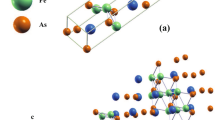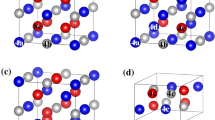Abstract
The electronic structure of the Mo\(_2\)BC and Mo\(_2\)B compounds was investigated by X-ray photoelectron spectroscopy. The Mo 3d, C 1s, and B 1s core levels are identified. For the Mo\(_2\)BC, the core-level binding energies corresponding to Mo 3d\(_{5/2}\), B 1s, and C 1s are localized at 227.90, 187.94, and 282.95 eV, respectively, whereas for the Mo\(_2\)B, the Mo 3d\(_{5/2}\), and B 1s are localized at 228.09 and 188.06 eV, respectively. Core-level binding energies shifts are observed in both compounds using the charge-potential model. The electronic density of states was calculated for Mo\(_2\)B and Mo\(_2\)BC using GGA approximation. Our results show that the electronic density of states at the Fermi level in the Mo\(_2\)B is higher than that in the Mo\(_2\)BC. The dominance of the Mo 4d states down to 8 eV below the Fermi level is found. The calculated total DOS was consistent with the XPS valence band spectra. Finally, within the BCS theory framework, the presence of superconductivity in both compounds can not be explained only as a function of the electronic density of states at the Fermi level. The electron-phonon coupling constant (\(\lambda \)) was calculated using the McMillan equation; the obtained values were 0.75 for Mo\(_{2}\)BC and 0.70 for Mo\(_{2}\)B. These values indicate that both compounds are intermediate coupled superconductors.






Similar content being viewed by others

References
Nagamatsu J, Nakagawa N, Muranaka T, Zenitani Y, Akimitsu JJ (2001) Superconductivity at 39 K in magnesium diboride. Nature 410:63–64
Buzea C, Yamashita T (2001) Review of the superconducting properties of MgB\(_2\). Supercond Sci Technol 14:R115–R146
Kiessling R (1947) The crystal structures of molybdenum and tungsten borides. Acta Chem Scand 1:893–916
Zhou D, Wang J, Cui Q, Li Q (2014) Crystal structure and physical properties of Mo\(_2\)B: first-principle calculations. J Appl Phys 115:113504
Jeitschko W, Nowotny H, Benesovsky F (1963) Die Kristallstruktur von Mo\(_2\)BC. Monatsh Chem 94:565–568
Lejay P, Chevalier B, Etourneau J, Hagenmuller P (1981) Influence of some metal substitutions on the superconducting behaviour of molybdenum borocarbide. J Less Common Met 82:193–200
Engelhardt JJ (1969) Superconducting isotope effect in molybdenum boride and tungsten boride. Phys Rev 179:452–458
Fisk Z (1991) Superconducting borides. AIP Conf Proc 231:155–164
Yamamoto A, Takao C, Masui T, Izumi M, Tajima S (2002) High-pressure synthesis of superconducting Nb\(_{1-x}\)B\(_2\) (x = 0–0.48) with the maximum T\(_c\) = 9.2 K. Phys C 383:197–206
Escamilla R, Lovera O, Akachi T, Duran A, Falconi R, Morales F, Escudero R (2004) Crystalline structure and the superconducting properties of NbB\(_{2+x}\). J Phys 16:5979–5990
Young DP, Goodrich RG, Adams PW, Chan JY, Fronczek FR, Drymiotis F, Henry LL (2002) Superconducting properties of BeB\(_{2.75}\). Phys Rev B 65:80518(R)
Bolvardi HI, Emmerlich J, Baben M, Music D, von Appen J, Dronskowski R, Schneider JM (2013) ystematic study on the electronic structure and mechanical properties of X2BC (X = Mo, Ti, V, Zr, Nb, Hf, Ta and W). J Phys 25:045501
Emmerlich J, Music D, Braun M, Fayek P, Munnik F, Schneider JM (2009) A proposal for an unusually stiff and moderately ductile hard coating material: Mo\(_2\)BC. J Phys D 42:185406
Falconi R, de la Mora P, Morales F, Escamilla R, Camacho CO, Acosta M, Escudero R (2015) High-pressure and electronic band structure studies on Mo\(_2\)BC. J Low Temp Phys 179:158–165
Altomare A, Burla MC, Giacovazzo C, Guagliardi A, Moliterni AG, Polidori G, Rizzi R (2001) Quanto: a Rietveld program for quantitative phase analysis of polycrystalline mixtures. J Appl Crystallogr 34:392–397
2004 SDP v4.1 (32 bit) Copyright XPS International, LLC, Compiled 17 January (2004)
Payne MC, Teter MP, Allan DC, Arias TA, Joannopoulos JD (1992) Iterative minimization techniques for ab initio total-energy calculations: molecular dynamics and conjugate gradients Rev. Mod Phys 64:1045–1097
Segall MD, Lindan PJD, Probert MJ, Pickard CJ, Hasnip PJ, Clark SJ, Payne MC (2002) First-principles simulation: ideas, illustrations and the CASTEP code. J Phys 14:2717–2744
Hohenberg P, Kohn W (1964) Inhomogeneous electron gas. Phys Rev 136:B864–B871
Kohn W, Sham LJ (1965) Self-consistent equations including exchange and correlation effects. Phys Rev 140:A1133–A1138
Perdew JP, Wang Y (1992) Accurate and simple analytic representation of the electron-gas correlation energy. Phys Rev B 45:13244–13249
Vanderbilt D (1990) Soft self-consistent pseudopotentials in a generalized eigenvalue formalism. Phys Rev B 41:7892–7895
Monkhorst HJ, Pack JD (1976) Special points for Brillouin-zone integrations. Phys Rev B 13:5188–5192
Radaelli PG, Hinks DG, Mitchell AW, Hunter BA, Wagner JL, Dabrowski B, Vandervoort KG, Viswanathan HK, Jorgensen JD (1994) Structural and superconducting properties of La\(_{2-x}\)Sr\(_x\)CuO\(_4\) as a function of Sr content. Phys Rev B 49:4163–4172
Xu C, Wang L, Liu Z, Chen L, Guo J, Kang N, Ma X-L, Cheng H-M, Ren W (2015) Large-area high-quality 2D ultrathin Mo\(_2\)C superconducting crystals. Nat Mater 14:1135–1141
Brainard WA, Wheeler DR (1978) An XPS study of the adherence of refractory carbide silicide and boride rf-sputtered wear-resistant coatings. J Vac Sci Technol 15:1801
Mavel G, Escard J, Costa P, Castaing J (1973) ESCA surface study of metal borides. Surf Sci 35:109–116
Sarma DD, Rao CNR (1980) XPES studies of oxides of second- and third-row transition metals including rare earths. J Electron Spectrosc Relat Phenom 20:25–45
Joyner DJ, Johnson O, Hercules DM (1970) A study of the iron borides. Electron spectroscopy. J Am Chem Soc 102:1910–1917
Escamilla R, Huerta L (2006) X-ray photoelectron spectroscopy studies of non-stoichiometric superconducting NbB\(_{2+x}\). Supercond Sci Technol 19:623–628
Kobayashi K, Mizokawa T, Mamiy K, Sekiyama A, Fujimori A, Takagi H, Eisaki H, Uchida S, Cava RJ, Krajewski JJ, Peck WF Jr. (1996) Photoemission study of Ni borocarbides: superconducting YNi\(_2\)B\(_2\)C and nonsuperconducting LaNi\(_2\)B\(_2\)C. Phys Rev B 54:507–514
Khyzhu OY (1999) Electronic structure and charge state of atoms of cubic and hexagonal tantalum carbides. Powder Metall Met Ceram 38:284–291
Magnuson M, Lewin E, Hultman L, Jansson U (2009) Electronic structure and chemical bonding of nanocrystalline-TiC/amorphous- C nanocomposites. Phys Rev B 80:235108
Furlan A, Lu J, Hultman L, Jansson U, Magnuson M (2014) Crystallization characteristics and chemical bonding properties of nickel carbide thin film nanocomposites. J Phys 26:415501
Dai-Yi Q, Zi G (1990) XPS study of tungsten carbide Chin. J Chem 8:301–305
Siegbahn K, Nordling C, Johansson G, Hedman J, Hedn PF, Hamrin K, Gelius U, Bergmark T, Werme LO, Manne R, Baer Y (1969) ESCA applied to free molecules. North-Holland, Amsterdam
Pauling L (1957) The nature of the chemical bond, 3rd edn. Cornell University Press, Ithaca
Talapatra A, Bandyopadhyay SK, Sen P, Barat B, Mukherjee S, Mukherjee M (2005) X-ray photoelectron spectroscopy studies of MgB\(_2\) for valence state of Mg. Phys C 419:141–147
Kurmaev EZ, McLeod JA, Buling A, Skorikov NA, Moewes A, Neumann M, Korotin MA, Izyumov YA, Ni N, Canfield PC (2009) Contribution of Fe 3d states to the Fermi level of CaFe\(_2\)As\(_2\). Phys Rev B 80:054508
Gamza M, Slebarski A, Deniszczyk J (2006) Electronic structure of CeRhIn\(_5\) and CeIrIn\(_5\). Mater Sci Pol 24:569–577
Likhachev ER, Dubrovskii OI, Kurganskii SI, Domashevskaya EP (1998) Analysis of photoelectron spectra of high-temperature superconductors. J Electron Spectrosc Relat Phenom 88–91:479–483
Vasquez RP, Jung CU, Park MS, Kim HJ, Kim JY, Lee SI (2001) X-ray photoemission study of MgB\(_2\). Phys Rev B 64:052510
Shen ZX, Lindberg PAP, Wells BO, Mitzi DB, Lindau I, Spicer WE, Kapitulnik A (1988) Valence-band and core-level photoemission study of single-crystal Bi\(_2\)CaSr\(_2\)Cu\(_2\)O\(_8\) superconductors. Phys Rev B 38:11820–11823
Bardeen J, Cooper LN, Schrieffer JR (1957) Theory of superconductivity. Phys Rev 108:1175–1204
Isaev EI, Ahuja R, Simak SI, Lichtenstein AI, Vekilov YK, Johansson B, Abrikosov IA (2005) Anomalously enhanced superconductivity and ab initio lattice dynamics in transition metal carbides and nitrides. Phys Rev B 72:064515
Junod A, Jarlborg T, Muller J (1983) Heat-capacity analysis of a large number of A15-type compounds. Phys Rev B 27:1568–1585
Paduani C (2007) Electronic Structure of the A3B Compounds: A = Nb; B = Al, Ga, Ge, Sn and In. Braz J Phys 37:1073–1076
Abd-Shukor R (2007) Electron-phonon coupling constant of cuprate based high temperature superconductors. Solid State Commun 142:587–590
Ledbetter H (1994) Dependence of T\(_c\) on Debye temperature \(\theta _{D}\) for various cuprates. Phys C 235–240:1325–1326
Toth LE, Zbasnik J, Sato Y, Gardner W (1968) Anisotropy in single-crystal refractory compounds. Plenum Press, New York, p 249
Blinder AV, Bolgar AS (1991) Heat capacity and enthalpy of transition-metal borides in a broad range of temperatures Soviet. Powder Metall Met Ceram 30:1053–1056
McMillan WL (1968) Transition temperature of strong-coupled superconductors. Phys Rev 167:331–344
Acknowledgements
The authors thank the Projects DGAPA-UNAM IN-106116, SIP-20141640 and SIP-20141641 from IPN. Financial support to PASPA-DGAPA and also, for their technical help to F. Silvar, M.M.S. Alberto Lopez-Vivas, J. Morales and C. González. Calculations were done using resources from the Supercomputing Center DGTIC-UNAM.
Author information
Authors and Affiliations
Corresponding author
Rights and permissions
About this article
Cite this article
Escamilla, R., Carvajal, E., Cruz-Irisson, M. et al. XPS study of the electronic density of states in the superconducting Mo2B and Mo2BC compounds. J Mater Sci 51, 6411–6418 (2016). https://doi.org/10.1007/s10853-016-9938-z
Received:
Accepted:
Published:
Issue Date:
DOI: https://doi.org/10.1007/s10853-016-9938-z



